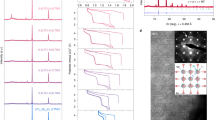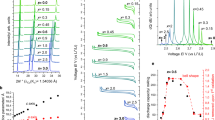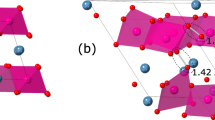Abstract
Anionic redox in Li-rich and Na-rich transition metal oxides (A-rich-TMOs) has emerged as a new paradigm to increase the energy density of rechargeable batteries. Ever since, numerous electrodes delivering extra anionic capacity beyond the theoretical cationic capacity have been reported. Unfortunately, most often the anionic capacity achieved in charge is partly irreversible in discharge. A unified picture of anionic redox in A-rich-TMOs is designed here to identify the electronic origin of this irreversibility and to propose new directions to improve the cycling performance of the electrodes. The electron localization function is introduced as a holistic tool to unambiguously locate the oxygen lone pairs in the structure and follow their participation in the redox activity of A-rich-TMOs. The charge-transfer gap of transition metal oxides is proposed as the pertinent observable to quantify the amount of extra capacity achievable in charge and its reversibility in discharge, irrespective of the material chemical composition. From this generalized approach, we conclude that the reversibility of the anionic capacity is limited to a critical number of O holes per oxygen, hO ≤ 1/3.
This is a preview of subscription content, access via your institution
Access options
Access Nature and 54 other Nature Portfolio journals
Get Nature+, our best-value online-access subscription
$29.99 / 30 days
cancel any time
Subscribe to this journal
Receive 12 print issues and online access
$259.00 per year
only $21.58 per issue
Buy this article
- Purchase on Springer Link
- Instant access to full article PDF
Prices may be subject to local taxes which are calculated during checkout






Similar content being viewed by others
Data availability
The datasets generated during and/or analysed during the current study are available from the corresponding author on reasonable request.
Change history
11 November 2019
An amendment to this paper has been published and can be accessed via a link at the top of the paper.
References
Padhi, A. K., Nanjundaswamy, K. S., Masquelier, C., Okada, S. & Goodenough, J. B. Effect of structure on the Fe3+–Fe2+ redox couple in iron phosphates. J. Electrochem. Soc. 144, 1609–1613 (1997).
Saubanère, M., Ben Yahia, M., Lebègue, S. & Doublet, M.-L. An intuitive and efficient method for cell voltage prediction of lithium and sodium-ion batteries. Nat. Commun. 5, 5559 (2014).
Koga, H. et al. Reversible oxygen participation to the redox processes revealed for Li1.20Mn0.54Co0.13Ni0.13O2. J. Electrochem. Soc. 160, A786–A792 (2013).
Sathiya, M. et al. Reversible anionic redox chemistry in high-capacity layered-oxide electrodes. Nat. Mater. 12, 827–835 (2013).
Sathiya, M. et al. High performance Li2Ru1−yMnyO3 cathode materials for rechargeable lithium-ion batteries: their understanding. Chem. Mater. 25, 1121–1131 (2013).
Luo, K. et al. Charge-compensation in 3d-transition-metal-oxide intercalation cathodes through the generation of localized electron holes on oxygen. Nat. Chem. 8, 684–691 (2016).
Yabuuchi, N. et al. High-capacity electrode materials for rechargeable lithium batteries: Li3NbO4-based system with cation-disordered rocksalt structure. Proc. Natl Acad. Sci. USA 112, 7650–7655 (2015).
McCalla, E. et al. Visualization of O–O peroxo-like dimers in high-capacity layered oxides for Li-ion batteries. Science 350, 1516–1521 (2015).
Pearce, P. E. et al. Evidence for anionic redox activity in a tridimensional-ordered Li-rich positive electrode β-Li2IrO3. Nat. Mater. 16, 580–587 (2017).
Robertson, A. D. & Bruce, P. G. Mechanism of electrochemical activity in Li2MnO3. Chem. Mater. 15, 1984–1987 (2003).
Ito, D., Liu, Y., Chong, S. & Wu, Y.-F. Cyclic deterioration and its improvement for Li-rich layered cathode material Li[Ni0.17Li0.2Co0.07 Mn0.56O2. J. Power Sources 195, 567–573 (2010).
Croy, J. R. et al. First-charge instabilities of layered–layered lithium-ion-battery materials. Phys. Chem. Chem. Phys. 17, 24382 (2015).
Gent, W. E. et al. Coupling between oxygen redox and cation migration explains unusual electrochemistry in lithium-rich layered oxides. Nat. Commun. 8, 2091-1–12 (2017).
Lee, E. & Persson, K. A. Structural and chemical evolution of the layered Li-excess LixMnO3 as a function of Li content from first-principles calculations. Adv. Energy Mater. 4, 1400498 (2014).
Qian, D., Xu, B., Chic, M. & Meng, Y. S. Uncovering the roles of oxygen vacancies in cation migration in lithium excess layered oxides. Phys. Chem. Chem. Phys. 16, 14665–14668 (2014).
Xie, Y., Saubanère, M. & Doublet, M.-L. Requirements for reversible extra-capacity in Li-rich layered oxides for Li-ion batteries. Energy Env. Sci. 10, 266–274 (2017).
Urban, A., Matts, I., Abdellahi, A. & Ceder, G. Computation design and preparation of cation-disordered oxides for high-energy-density Li-ion batteries. Adv. Energy Mater. 6, 1600488-1–1600488-8 (2016).
Li, B. & Xia, D. Anionic redox in rechargeable lithium batteries. Adv. Mater. 29, 1701054-1–28 (2017).
Li, W., Song, B. & Manthiram, A. High-voltage positive electrode materials for lithium-ion batteries. Chem. Soc. Rev. 46, 3006–3059 (2017).
Assat, G. & Tarascon, J.-M. Fundamental understanding and practical challenges of anionic redox activity in Li-ion batteries. Nat. Energy 3, 376–286 (2018).
Yabuuchi, N. et al. A new electrode material for rechargeable sodium batteries: P2-type Na2/3[Mg0.28Mn0.72]O2 with anomalously high reversible capacity. J. Mater. Chem. A 2, 16851–16855 (2014).
Maitra, U. et al. Oxygen redox chemistry without excess alkali-metal ions in Na2/3[Mg0.28Mn0.72]O2. Nat. Chem. 10, 288–295 (2018).
Seo, D.-H. et al. The structural and chemical origin of the oxygen redox activity in layered and cation-disordered Li-excess cathode materials. Nat. Chem. 8, 692–697 (2016).
Saubanère, M., McCalla, E., Tarascon, J.-M. & Doublet, M.-L. The intriguing question of anionic redox in high-energy density cathodes for Li-ion batteries. Energy Env. Sci. 9, 984–991 (2016).
Perez., A. J. et al. Approaching the limits of cationic and anionic electrochemical activity with the Li-rich layered rocksalt Li3IrO4. Nat. Energy 2, 954–962 (2017).
Becke, A. D. & Edgecombe, K. E. A simple measure of electron localization in atomic and molecular systems. J. Chem. Phys. 92, 5397–5403 (1990).
House, R. et al. Lithium manganese oxyfluoride as a new cathode material exhibiting oxygen redox. Energy Environ. Sci. 11, 926–932 (2018).
Mortemard de Boisse, B. et al. Highly reversible oxygen-redox chemistry at 4.1 V in Na4/7−x[X 1/7Mn6/7]O2 (X:Mn vacancy). Adv. Energy Mater. 8, 1800409 (2018).
Hong, J. et al. Review—Lithium-excess layered cathodes for lithium rechargeable batteries. J. Electrochem. Soc. 162, A2447–A2467 (2015).
Rozier, P. & Tarascon, J. M. Review—Li-rich layered oxide cathodes for next-generation Li-ion batteries: chances and challenges. J. Electrochem. Soc. 162, A2490–A2499 (2015).
Croy, J. R., Balasubramanian, M., Gallagher, K. G. & Burrell, A. K. Review of the U. S. Department of Energy’s ‘Deep Dive’ effort to understand voltage fade in Li- and Mn-rich cathodes. Acc. Chem. Res. 48, 2813–2821 (2015).
Zheng, J. et al. Li- and Mn-rich cathode materials: challenges to commercialization. Adv. Energy Mater. 7, 1601284 (2016).
Hy, S. et al. Performance and design considerations for lithium excess layered oxide positive electrode materials for lithium ion batteries. Energy Environ. Sci. 9, 1931–1954 (2016).
Zaanen, J., Sawatzky, G. A. & Allen, J. W. Band gaps and electronic structure of transition-metal compounds. Phys. Rev. Lett. 55, 418–421 (1985).
Crabtree, R. H. The Organometallic Chemistry of the Transition Metals 3rd edn (Wiley, 2001).
Toriumi, K. & Saito, Y. Electron-density distribution in crystals of α-K2CrO4. Acta Crystallogr. B 34, 3149–3156 (1978).
Fischer, J., Veillard, A. & Weiss, R. Nature de la liaison dans l’ion tétraperoxochromate CrO8 3− : une étude des structures cristalline et électronique. Theor. Chim. Acta 24, 317–333 (1972).
Grimaud, A. et al. Chemical activity of the peroxide/oxide redox couple: case study of Ba5Ru2O11 in aqueous and organic solvents. Chem. Mater. 30, 3882–3893 (2018).
Assat, G. et al. Fundamental interplay between anionic/cationic redox governing the kinetics and thermodynamics of lithium-rich cathodes. Nat. Commun. 8, 2219 (2017).
Rouxel, J. Anion–cation redox competition and the formation of new compounds in highly covalent systems. Chem. Eur. J. 2, 1053–1059 (1996).
Rouxel, J. Some solid state chemistry with holes: anion–cation redox competition in solids. Curr. Sci. 73, 31–39 (1997).
Yabuuchi, N. Material design concept of lithium-excess materials with rocksalt-related structures for rechargeable non-aqueous batteries. Chem. Rec. 18, 1–19 (2018).
Sathiya, M. et al. Origin of voltage decay in high-capacity layered oxide electrodes. Nat. Mater. 14, 230–238 (2015).
Kalyani, P., Chitra, S., Mohan, T. & Gopukumar, S. Lithium metal rechargeable cells using Li2MnO3 as the positive electrode. J. Power Sources 80, 103–106 (1999).
Armstrong, A. R., Robertson, A. D. & Bruce, P. G. Overcharging manganese oxides: extracting lithium beyond Mn4+. J. Power Sources 146, 275–280 (2005).
Freire, M., Lebedev, O. I., Maignan, A., Jordi, C. & Pralong, V. Nanostructured Li2MnO3: a disordered rock salt type structure for high energy density Li ion batteries. J. Mater. Chem. A 5, 21898–21902 (2017).
Sato., K. et al. Na-excess cation-disordered rocksalt oxide: Na1.3Nb0.3Mn0.4O2. Chem. Mater. 29, 5043–5047 (2017).
Yabuuchi, N. et al. Origin of stabilization and destabilization in solid-state redox reaction of oxide ions for lithium-ion batteries. Nat. Commun. 7, 13814 (2016).
Lee, J. et al. Reversible Mn2+/Mn4+ double redox in lithium-excess cathode materials. Nature 556, 185–190 (2018).
Kresse, G. & Furthmüller, J. Efficiency of ab-initio total energy calculations for metals and semiconductors using a plane-wave basis set. Comput. Mater. Sci. 6, 15–50 (1996).
Kresse, G. & Hafner, J. Ab initio molecular dynamics for liquid metals. Phys. Rev. B 47, 558–561 (1993).
Perdew, J. P., Burke, K. & Ernzerhof, M. Generalized gradient approximation made simple. Phys. Rev. Lett. 77, 3865–3868 (1996).
Dudarev, S. L., Botton, G. A., Savrasov, S. Y., Humphreys, C. J. & Sutton, A. P. Electron-energy-loss spectra and the structural stability of nickel oxide: an LSDA + U study. Phys. Rev. B 57, 1505–1509 (1998).
Heyd, J., Scuseria, G. E. & Ernzerhof, M. Hybrid functionals based on a screened Coulomb potential. J. Chem. Phys. 118, 8207–8210 (2003).
Monkhorst, H. J. & Pack, J. D. Special points for Brillouin-zone integrations. Phys. Rev. B 13, 5188–5192 (1976).
Blöchl, P. E. Projector augmented-wave method. Phys. Rev. B 50, 17953–17979 (1994).
Savin, A. et al. Electron localization in solid-state structures of the elements: the diamond structure. Angew. Chem. Int. Ed. Engl. 31, 187–188 (1992).
Causà, M., D’Amore, M., Gentile, F., Menendez, F. & Calatayud, M. Electron localization function and maximum probability domains analysis of semi-ionic oxides crystals, surfaces and surface defects. Comput. Theor. Chem. 1053, 315–321 (2015).
Acknowledgements
The authors acknowledge the RS2E institution and the Agence Nationale pour la Recherche (ANR)—DeliRedox no. ANR-14-CE05-0020—for supporting this work. Part of this work was supported by the EU through the POROUS4APP project—H2020-NMP-PILOT-2015 no. 686163.
Author information
Authors and Affiliations
Contributions
All authors contributed equally to the DFT calculations and analyses. M.S. and M.-L.D. developed the theoretical framework and wrote the paper.
Corresponding authors
Ethics declarations
Competing interests
The authors declare no competing interests.
Additional information
Publisher’s note: Springer Nature remains neutral with regard to jurisdictional claims in published maps and institutional affiliations.
Supplementary information
Supplementary Information
Supplementary Notes 1,2, Supplementary Figures 1,2, Supplementary References 1–11
Rights and permissions
About this article
Cite this article
Ben Yahia, M., Vergnet, J., Saubanère, M. et al. Unified picture of anionic redox in Li/Na-ion batteries. Nat. Mater. 18, 496–502 (2019). https://doi.org/10.1038/s41563-019-0318-3
Received:
Accepted:
Published:
Issue Date:
DOI: https://doi.org/10.1038/s41563-019-0318-3
This article is cited by
-
Decoupling the roles of Ni and Co in anionic redox activity of Li-rich NMC cathodes
Nature Materials (2023)
-
Delocalized electron holes on oxygen in a battery cathode
Nature Energy (2023)
-
A Li-rich layered oxide cathode with negligible voltage decay
Nature Energy (2023)
-
An overview of effect of process parameters for removal of CO2 using biomass-derived adsorbents
Biomass Conversion and Biorefinery (2023)
-
Understanding voltage hysteresis and decay during anionic redox reaction in layered transition metal oxide cathodes: A critical review
Nano Research (2023)



